Fillmore Place is one step closer to being an official NYC historic district (and its the most important step – LPC designation).
Cleaning the BQE

The underside of the BQE got a steam cleaning this evening.

The underside of the BQE got a steam cleaning this evening.
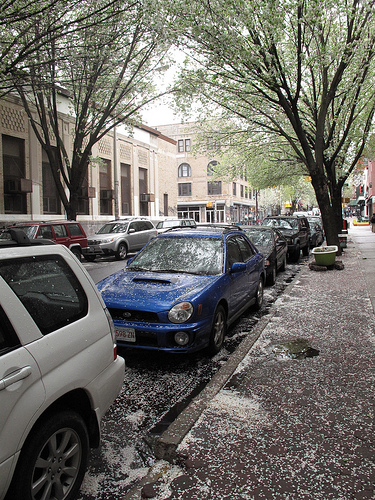
Havemeyer Street
Photo: kurtrik via brooklyn11211 flickr pool
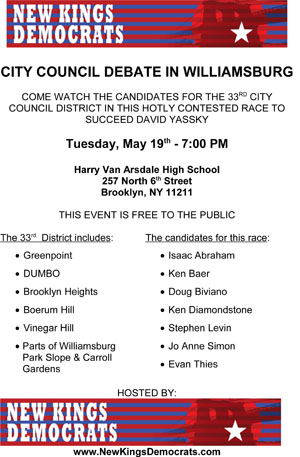
Tomorrow evening (May 19th) New Kings Democrats is hosting a debate for the open seat in the 33rd Council District. In case you haven’t been paying attention (and you should be) Councilmember David Yassky is not running for reelection (he’s running for Comptroller). As of today, there are seven candidates looking to fill Yassky’s seat (which covers Greenpoint, parts of Williamsburg, Vinegar Hill, DUMBO, Brooklyn Heights, Boerum Hill and parts of Park Slope and Carrol Gardens.
When: Tuesday, May 19 – 7:00 p.m.
Where: Harry Van Arsdale High School (257 North 6th Street at Roebling).
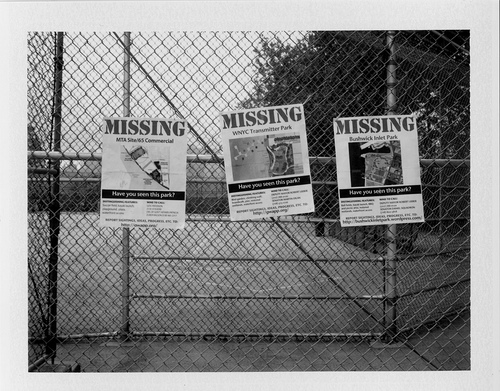
Photo: NAG
We were out of town for the weekend, so missed Saturday’s “Where’s My Park? Day” event (and the relatively nice weather – we were fogged in on Saturday). But as NAG reports, not only was the event was a success, but there is progress to show for it. Stephanie Thayer of Parks (and OSA) emailed NAG prior to Saturday’s event to make the following the promises on behalf of the City:
1. Manhattan Avenue Street end greening is open to the public as of [Saturday].
2. Northside Piers (at North 5th St/Kent Ave.) will be open 7 days per week within the next two weeks.
3. We will break ground on the first phase of Bushwick Inlet Park, a soccer field, between North 9th and North 10th, in June.
[We knew all of this already, but it gets better…]
4. Transmitter Park will be opened for use this summer, with interior fencing that provides as much safe site access as possible.
5. We are working to improve Newton Barge Terminal Park to provide waterfront views this summer.
6. Mayor’s office will proceed with an independent study to further the relocation of the MTA.
7. Parks Dept. will hold regular public listening sessions about the parks commitments of the rezoning [from what I’ve been told, there will be monthly progress updates].

Assemblyman Lentol looks for his park.
Photo: NAG
NAG attributes this progress to “the public attention that was brought to the promises from the 2005 rezoning going unfulfilled”, which has definitely ratcheted up in the past few weeks. Councilmember Yassky’s press conference on the MTA site last week and “Where’s My Park? Day” were the most conspicuous, but there was also a lot of press and a few blog posts to help things along.
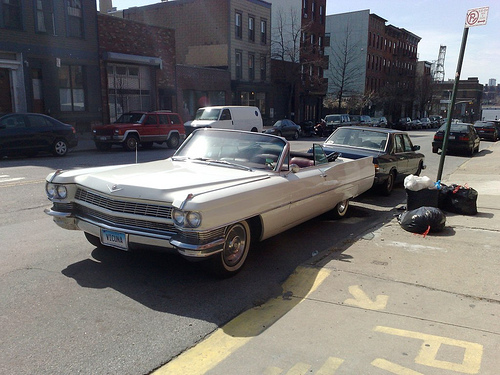
Grand Street, Spring 2009
Photo: Grifforama via brooklyn11211 flickr pool
Our inaugural photo pool entry, thanks to Grifforama. I guess if you own a car this fantastic, you get to park it backwards.
So let’s see if we can end parks week on a (slightly) up note, by highlighting some of the good news out there.
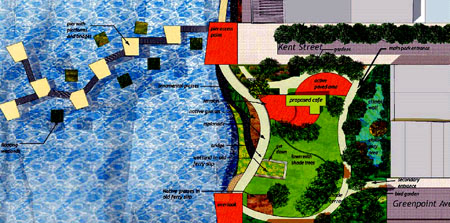
Transmitter Park, original (2008) design.
Image via Newyorkshitty
First off, Transmitter Park, which is slated to go in at the former WNYC transmitter site at the foot of Greenpoint Avenue. The property is owned by the City, so acquisition is not an issue. A design (above) was issued more than a year ago. That has required some modification to comply with NYState DEC regulations, but that has all been worked out, and the fish are protected. So everything should be poised to move forward, right? Well sort of – the Daily News reported this week that Transmitter Park is expected to be completed in Summer 2011. And it’s not clear to me that the money for this capital project has even been allocated. Which in this economic environment spells trouble.
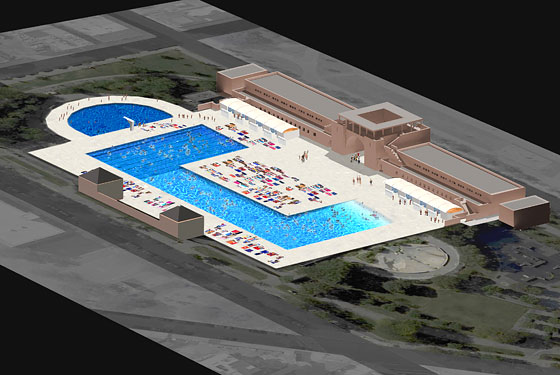
McCarren Park Pool, preliminary design
Rogers Marvel Archtiects
One project where the money has been allocated and construction has started is McCarren Park Pool. The Department of Parks & Recreation selected an architect over a year ago and held a successful series of community charettes to get ideas on programming, etc. That resulted in an exciting design, which the City has allocated funds to construct – $50 million in funds, in fact. Unfortunately, $50 million does not go as far today as it did two years ago, so the diving pool has been value engineered out of the project. But the main pool and the restoration of the landmarked pool house is going forward.
Because a blog can never have enough photos of Brooklyn, I’ve created a brooklyn11211 photo pool on flickr. Just click on the link in the masthead portion of this page (or this link here), join the group and upload your photos. Impress me.

Photo: vidiot on flickr
Jeremiah takes a walk down Franklin Street and doesn’t exactly like what he sees. Things like “outdoor cafes packed with wafer-thin women cradling chihuahuas in their laps, bars with clever names, ‘craft brew’ beer stores [where is that?], and coffee shops filled with bearded men peering at Mac laptops through chalk-white Wayfarer shades.” In short, everything he saw as authentic on his tour of Manhattan Avenue is threatened by the renaissance of Franklin Street.
Personally, I think the dichotomy of Manhattan Avenue and Franklin Street is a fascinating – and so far positive – urban study. Yes, Franklin Street is gentrifying, but what’s interesting is that it is not gentrifying at the expense of Manhattan Avenue. The two really exist as parallel universes. Nor is the gentrification of Franklin Street pushing out local stores. 100 years ago, Franklin Street was filled with locally-owned ground-floor retail stores. Ten years ago, most of Franklin Street was not retail – the old storefronts were vacant or had been converted to apartments. As new people came into the neighborhood looking to open businesses, they found a ready stock of underutilized commercial space. The same thing has been happening along Grand Street west of the BQE – storefronts that had been vacant for decades are suddenly being reborn as bars, restaurants, boutiques, bicycle shops, book stores and much more. Local businesses owned by local residents, and by and large, none of it is displacing older businesses.
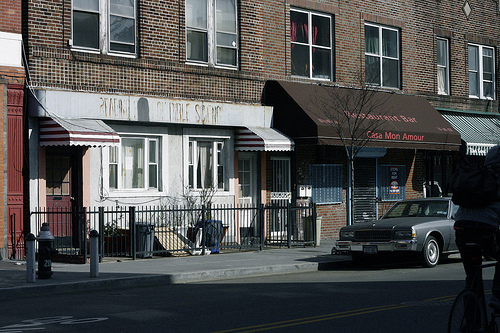
Layers of history – former storefronts that had been bricked in are now being reopened.
Photo: ashfordesign on flickr
This is exactly the kind of development most urbanists would love to see. And it came about not through some planner drawing a line on a map, but rather as a result of a series of individual decisions, all of which started with a recognition of a quality, underutilized building stock. Instead of boarded up storefronts, it’s eyes on the street in the classic Jane Jacobs sense. It’s economic development from the bottom up. It’s more local jobs where none had existed for decades. It’s more income for building owners, many of whom are also locals (and long-timers). Sure it’s (generally) serving one segment of the population, but it can be benefitting many segments. And sure it’s a fragile ecosystem that needs to be carefully nurtured. It could all go to pot and become Soho, or expand east to Manhattan Avenue and displace long-time businesses there.